

Zitierweise / cite as:
Payer, Alois <1944 - >: Chronik Thailands = กาลานุกรมสยามประเทศไทย. -- Chronik 1868-11 - 1868-12 (Rama V.). -- Fassung vom 2016-01-06. -- URL: http://www.payer.de/thailandchronik/chronik1868b.htm
Erstmals publiziert: 2013-09-10
Überarbeitungen: 2016-01-06 [Ergänzungen] ; 2015-09-12 [Ergänzungen] ; 2015-04-28 [Ergänzungen] ; 2013-09-14 [Ergänzungen]
©opyright: Dieser Text steht der Allgemeinheit zur Verfügung. Eine Verwertung in Publikationen, die über übliche Zitate hinausgeht, bedarf der ausdrücklichen Genehmigung des Herausgebers.
Dieser Text ist Teil der Abteilung
Thailand von
Tüpfli's Global Village Library
ช้างตายทั้งตัวเอาใบบัวปิดไม่มิด
|
Gewidmet meiner lieben Frau Margarete Payer die seit unserem ersten Besuch in Thailand 1974 mit mir die Liebe zu den und die Sorge um die Bewohner Thailands teilt. |
|
Bei thailändischen Statistiken muss man mit allen Fehlerquellen rechnen, die in folgendem Werk beschrieben sind:
Die Statistikdiagramme geben also meistens eher qualitative als korrekte quantitative Beziehungen wieder.
|
1868-11-11 - 1910-10-23 / 2411 - 2453

Rama V.: Phra Bat Somdet Phra Poramintharamaha Chulalongkorn Phra Chunla Chom Klao Chao Yu Hua - พระบาทสมเด็จพระปรมินทรมหาจุฬาลงกรณ์ฯ พระจุลจอมเกล้าเจ้าอยู่หัว
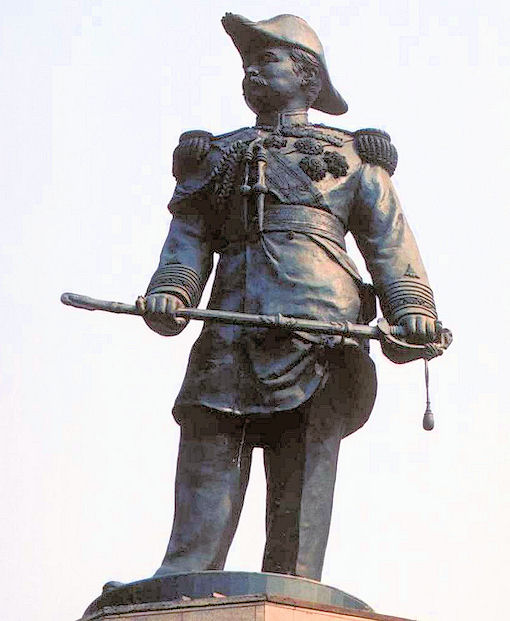
Abb.: Rama V. -- Chulachomklao Fort, Amphoe Pra Samut Chedit -
อำเภอพระสมุทรเจดีย์,
Samut Prakan Province - จังหวัดสมุทรปราการ
[Bildquelle: Ahoerstemeier / Wikimedia. -- GNU FDLicense]
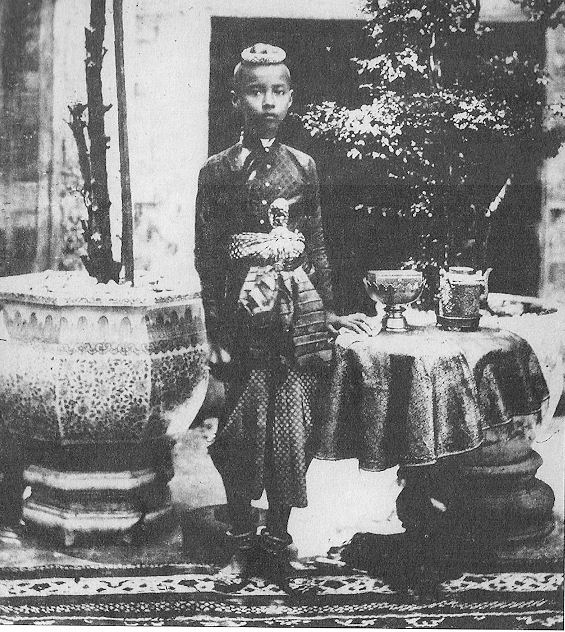
Abb.: Prinz Chulalongkorn, ca. 1865
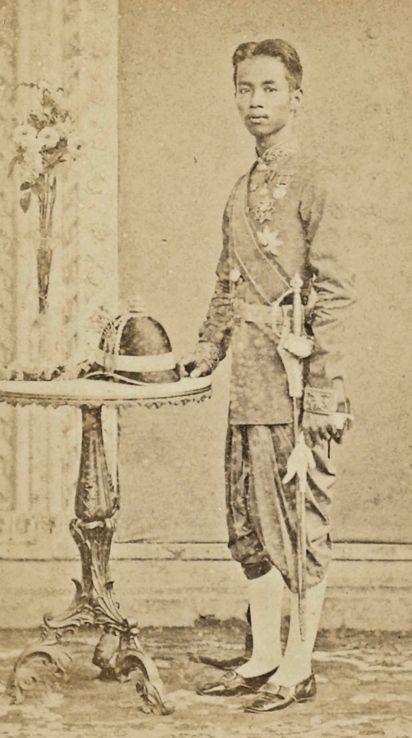
Abb.: Prinz Chulalongkorn, ca. 1868
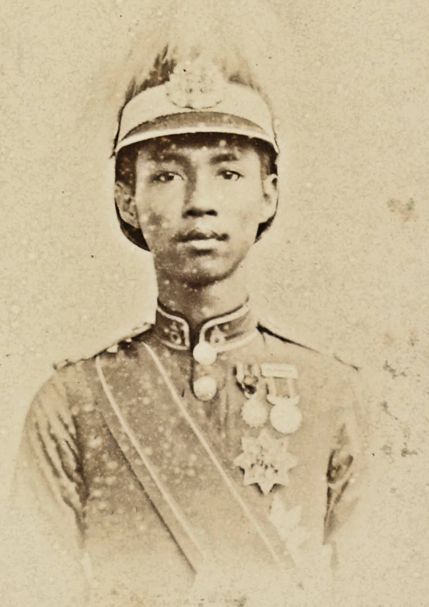
Abb.: Prinz Chulalongkorn, ca. 1868
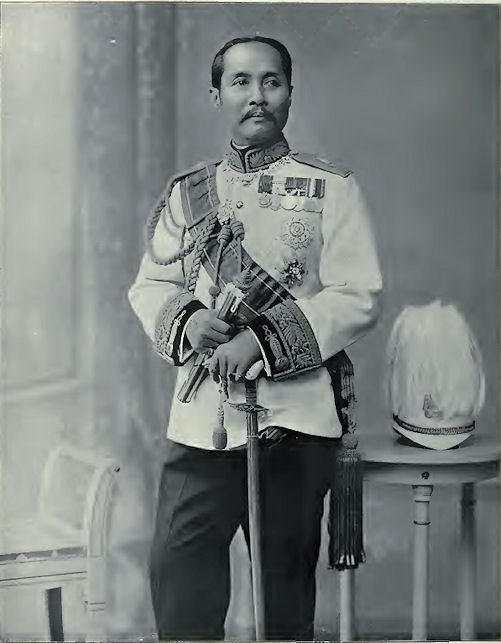
Abb.: Rama V.
[Bildquelle:
Twentieth century impressions of Siam : its history, people, commerce,
industries, and resources / ed. in chief: Arnold Wright. -- London [etc.] :
Lloyds, 1908. -- Frontispiece]
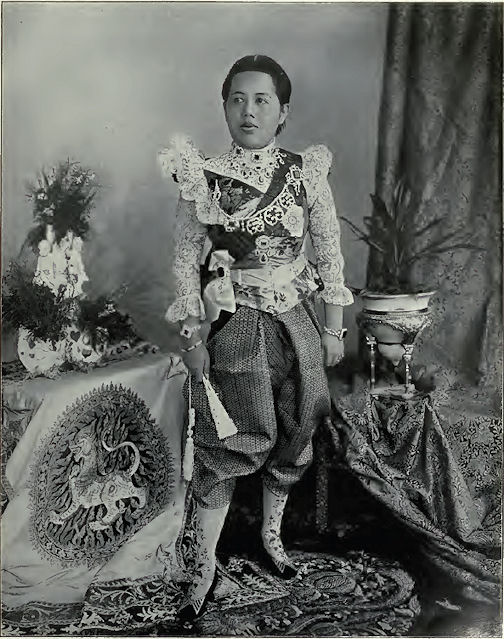
Abb.:
Königin Saowapha Bongsri -
เสาวภาผ่องศรี (1864 -
1919)
[Bildquelle:
Twentieth century impressions of Siam : its history, people, commerce,
industries, and resources / ed. in chief: Arnold Wright. -- London [etc.] :
Lloyds, 1908. -- Frontispiece]
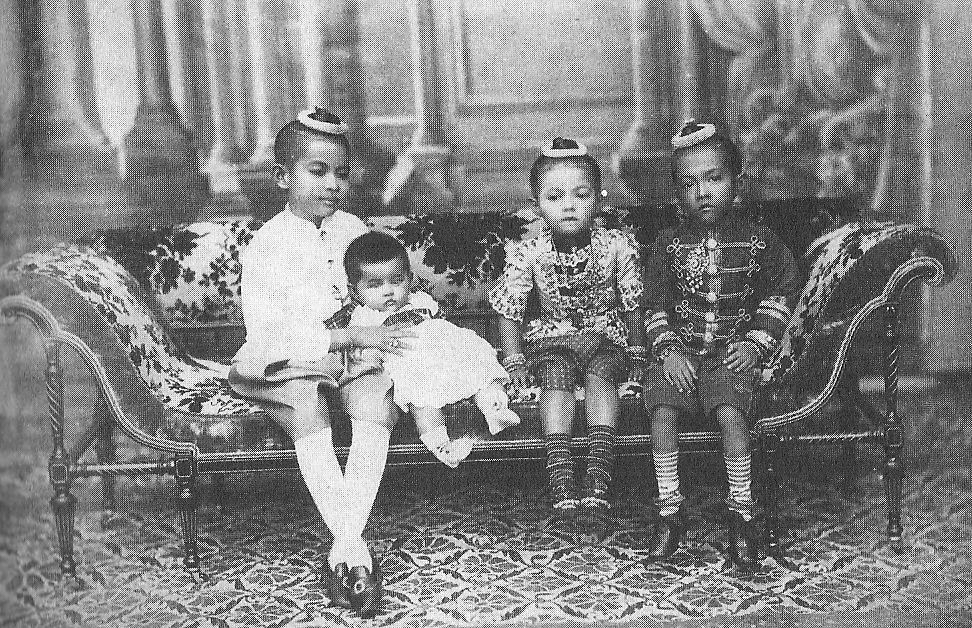
Abb.: Kinder Ramas V.
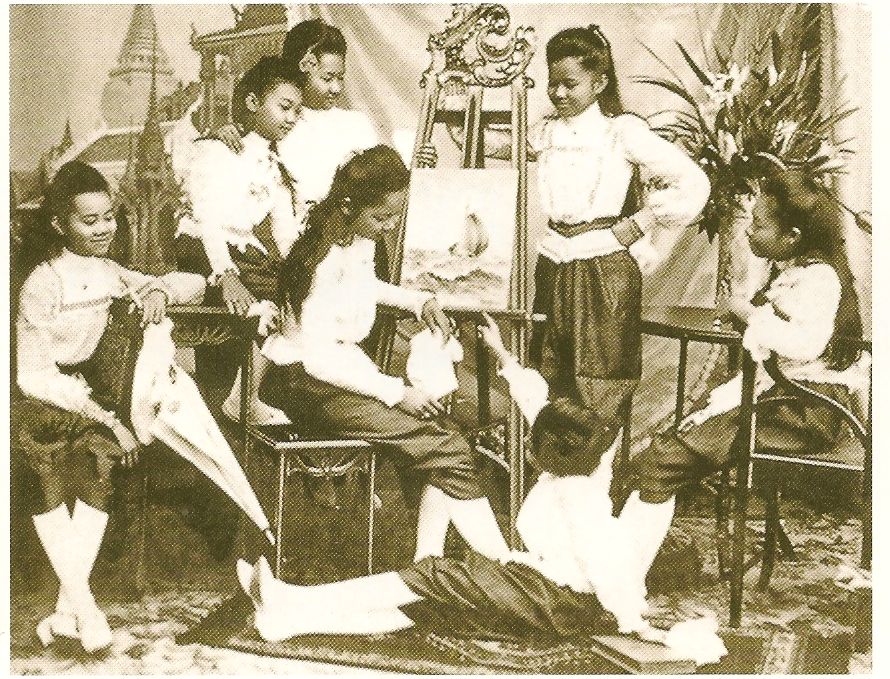
Abb.: Töchter Ramas V., mit langem Haar und europäischen Schuhen
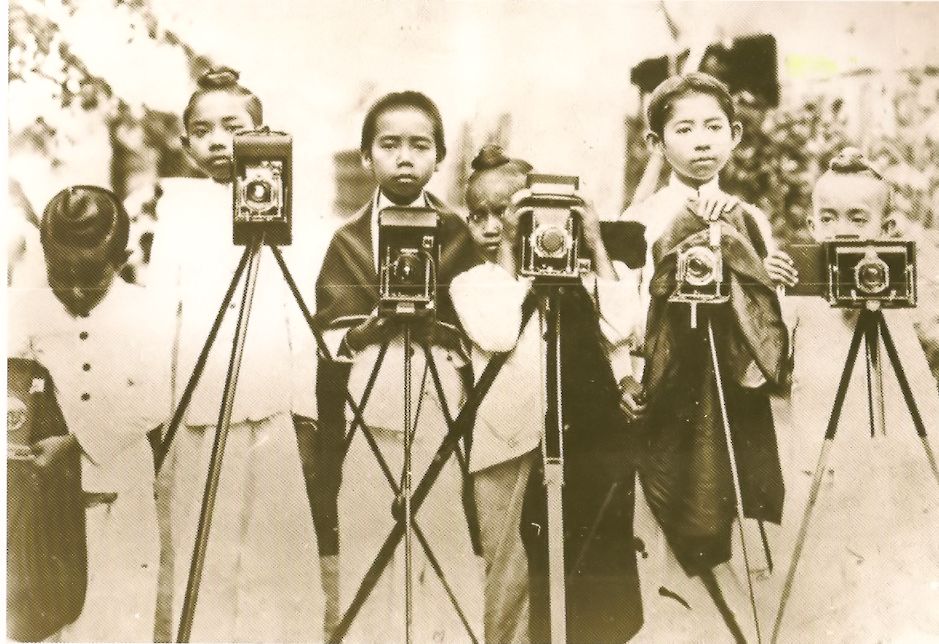
Abb.: Kinder Ramas V. mit Kameras
Von links nach rechts:
Prinz Amara Samarnlaksana Kitiyakara (อมร สมานลักษณ์ กิติยากร, 1896 - 1968)
Prinz Prajadhipok Sakdidejana (ประชาธิปก ศักดิเดชน์, 1893 - 1941; späterer Rama VII.)
Prinz Chudadhut Dharadilok (จุฑาธุช ธราดิลก, 1892 - 1923)
Prinzessin Sailathong Thongyai (ไศลทอง ทองไหญ่, 1893 - 1969)
Prinz Mahidol Adulyadej (มหิตล อดุลยเดช, 1892 - 1929; Vater von Rama VIII. und Rama IX.)
Prinz Urubongs Rajasombhoj (อุรุพงศ์ รัชสมโภช, 1893 - 1909)
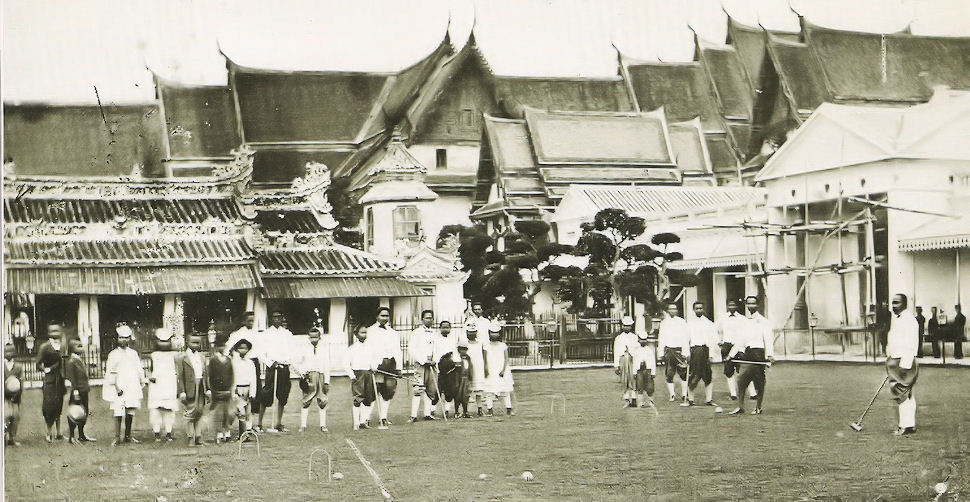
Abb.: Rama V. beim Croquet-Spiel
"König Chulalongkorn der Große, Rama V. (Regierungsname: Phra Chula Chomklao Chaoyuhua, in Thai พระบาทสมเด็จ พระจุลจอมเกล้าเจ้าอยู่หัว, gesprochen [pʰrábàːt sǒmdèt pʰrá ʨùláʨɔːmklâw ʨâwjùːhǔːa]; * 20. September 1853 in Bangkok, Thailand; † 23. Oktober 1910 in ebenda), war König von Siam (Thailand) vom 11. November 1868 bis zum 23. Oktober 1910. Beginn der Regierungszeit
Als ältester Sohn des an Malaria verstorbenen Königs Mongkut (Rama IV.) wurde er im Alter von 15 Jahren gekrönt. Die Macht lag zunächst bei Chaophraya Sisuriyawong (สมเด็จเจ้าพระยา บรมมหาศรีสุริยวงศ์ - Chuang Bunnag), der bis November 1873 Regent war.
Bei der 100-Jahres-Feier zum Bestehen der Chakri-Dynastie im Jahr 1882, nur 14 Jahre nach dem Tod seines Vaters, wurden fünf bedeutende Errungenschaften König Chulalongkorns für Siam bis zu diesem Zeitpunkt erwähnt:
- die allmähliche Gleichberechtigung bestimmter Klassen von Sklaven (Im Jahr 1905 wurde die Sklaverei endgültig abgeschafft und verboten, nachdem die wirtschaftliche Unabhängigkeit jedes Einzelnen gesichert werden konnte.),
- die Abschaffung der Niederwerfung vor dem König,
- die Garantie für Regierungsoffiziere, dem König schriftlich ihre Meinung zukommen lassen zu dürfen,
- die Verbesserung der Beziehungen zum Ausland,
- die Erweiterung des Wat Phra Kaeo.
Des Weiteren hatte er bereits eine Bildungsreform angestoßen, das Anlegen neuer Reisfelder unterstützt und die Wirtschaft durch das Graben neuer Kanäle angekurbelt.
PolitikAußenpolitik
Schon früh interessierte sich Chulalongkorn für die Situation im Ausland. Bereits 1870 besuchte er die zum niederländischen Kolonialreich gehörende Insel Java und 1871 bis 1872 Indien, wobei er vom seinerzeitigen britischen Generalkonsul Thomas George Knox (1824-1887) begleitet wurde[1].
Chulalongkorn galt als sehr erfolgreicher Außenpolitiker. Er knüpfte als erster König Siams direkte Kontakte zu den europäischen Königshäusern. Zwei Reisen führten ihn 1897 und 1907 nach Europa, unter anderem auch nach Deutschland, wo er in Heidelberg beispielsweise seinen Sohn Prinz Rangsit von Chainad besuchte, der dort von 1905 bis 1913 studierte und 1912 die Heidelbergerin Elisabeth Scharnberger heiratete.
Das erste siamesische Filmdokument zeigt die Ankunft des Königs Chulalongkorn in Bern am 25. Mai 1897. Im Jahr 1900 wurde von Prinz Sanbhassatra, dem jüngeren Bruder des Königs, der erste Film in Thailand selbst gedreht.
In seinen gesamten 42 Regierungsjahren ist Siam zu einem modernen Staat entwickelt worden, der seine Unabhängigkeit gegen den starken Druck von Großbritannien und Frankreich verteidigen konnte und der seine Verwaltung und sein Wirtschaftssystem konkurrenzfähig gestaltet hat. Alle Nachbarn Siams wurden kolonisiert, Rama V. konnte durch die Übergabe kleinerer Teile des Reiches die Integrität Siams bewahren: Teile von Laos kamen an Frankreich, vier südliche Provinzen gingen an die Malaien (also England). Siam bildete einen respektierten Pufferstaat zwischen den Kolonialgebieten Südostasiens.
Frage der ThronfolgeKönig Chulalongkorn schaffte nach dem Tod seines Vizekönigs (Uparatcha) Prinz Wichaichan im Jahr 1885 das Amt des Vizekönigs ab und führte stattdessen die Ernennung eines Thronnachfolgers als Kronprinzen ein. Im Januar 1887 setzte er den neunjährigen Chaofa-Prinzen Wachirunhit als Siams ersten Kronprinzen (sayam makut ratchakuman) ein. Nach dem Tod des jungen Kronprinzen am 4. Januar 1895 wurde der vierzehnjährige Prinz Vajiravudh (Rama VI.) zum neuen Kronprinzen erklärt.
InnenpolitikNach dem Ende der Regentschaft Sisuriyawongs im November 1873, richtete König Chulalongkorn im Mai 1874 einen Staatsrat ein. Im August 1874 folgte die Einführung eines Kronrats (engl.: Privy Council), dessen (zunächst 49) Mitglieder den König persönlich beraten sollten.
Große Umwälzungen im Staats- und Regierungsapparat fanden in den Jahren 1887 bis 1892 statt, wobei 1892 als das große Reformjahr gilt. Diese Reformen waren nicht zuletzt eine Antwort auf die zunehmende Bedrohung durch die britischen und französischen Kolonialmächte, die ihre Herrschaft über sämtliche Nachbarstaaten gesichert hatten. Siam musste eine starke Großnation werden, und so wurden durch Verwaltungsreformen auch die Verbindungen zu den Vasallenstaaten im Norden und Nordosten verstärkt. Aus strategischen Gründen wurde der Bau von Eisenbahnstrecken in diese Landesteile angestoßen.
Im April 1882 ernannte König Chulalongkorn (als weiterhin absoluter Monarch, der keinerlei Macht delegierte) ein neues Kabinett aus zwölf Mitgliedern, die loyal zu ihm standen, darunter neun Brüder von ihm.
Eine größere Kabinettsumbildung gab es 1896. Die Hauptposten gingen wieder an Brüder des Königs: Damrong (Inneres), Mahit (Finanzen und Landwirtschaft), Phithayalap (Palast und Öffentlichkeitsarbeit), Thewawong (Auswärtiges), Narit (Armee) und Naret (lokale Administration/ Local Government). Neu hinzu kam 1897 der junge Prinz Ratburi (Ratchaburidirekruet), der frisch von seinem Studium in Oxford zurückgekehrt war. Er war damit der erste von Chulalongkorns Söhnen, der einen Ministerrang erhielt.
BildungspolitikDie Bildungsanstrengungen seiner Vorgänger setzte Rama V. fort. Hervorragende Schüler wurden ohne Ansehen ihrer Herkunft mit Stipendien versehen und nach Europa (England, Dänemark, Deutschland, Russland) geschickt. Auch ließ er königliche Schulen für die Bevölkerung bauen. Die Einführung der englischen Sprache als Unterrichtsfach förderte das Verständnis für die westliche Kultur. Bei seinen vielen teils überraschenden und manchmal auch anonymen Reisen durch das Land konnte der König viele Schwachstellen in der Verwaltung und in der Rechtspflege aufdecken und beheben. So entstanden viele kleine Reformen und Verbesserungen, die den Status der Verwaltung stärkten und das Vertrauen der Bevölkerung in den Staat, insbesondere in die Monarchie, festigten.
ReligionspolitikChulalongkorn war dem Buddhismus sehr tief verbunden. Als solchem lag ihm die Missionierung Andersgläubiger fern, im Gegenteil sorgte er durch Landschenkungen dafür, dass christliche Kirchen und Moscheen gebaut werden konnten. Es herrschte Religionsfreiheit.
Ausbau der InfrastrukturDer König betrieb auch eine konsequente Modernisierungspolitik. Zahlreiche ausländische Berater wurden für Siam tätig, hauptsächlich in der Verwaltung und beim technischen Ausbau des Landes. Während der frühen 1890er Jahre erhielt Siam Hilfe bei zahlreichen Entwicklungsprojekten von mehr als hundert ausländischen technischen Spezialisten. Die meisten waren Briten, Dänen und Deutsche. (Es gab französische Missionare und diplomatische Vertreter, jedoch keine technischen Berater.)
Das thailändische Eisenbahnnetz wurde mit deutschem technischen Personal und zahlreichen chinesischen Arbeitern gebaut.
Im Jahr 1897 arbeiteten folgende Ausländer im siamesischen Staatsdienst: 54 Engländer, 20 Dänen, 18 Deutsche, 9 Belgier, 7 Italiener, und ein paar Niederländer, Österreicher, Amerikaner, Portugiesen und Schweizer. Die Verwaltungsreformen König Chulalongkorns verbesserten auch das Polizeiwesen, sowie den Post- und Telegrafendienst. Die erste Telefonverbindung entstand 1881. Das Gerichtswesen wurde reformiert. Das Provinzialgerichte-Gesetz von 1896 brachte das gesamte Gerichtswesen auf Provinzialebene unter Bangkoks Aufsicht.
Außerdem erfolgte unter König Chulalongkorn der Bau von Krankenhäusern, wobei das erste Krankenhaus des Landes in Siriraj erst nach jahrelangen Auseinandersetzungen gebaut und 1896 eröffnet werden konnte. Die meisten Thais waren Anhänger der Kräutermedizin und daher skeptisch gegenüber der „Farang-Medizin“. Außerdem fehlte es zunächst noch an qualifizierten, thailändischen Ärzten, die das Vertrauen der Bevölkerung hätten festigen können.
AuslandsreisenDer Innere Palast
- 9. März 1871 - 15. April 1871: Singapur und Batavia
- Zweite Reise (frühe 1870er Jahre): Singapur, Malakka, Penang, Moulmein (Mon-Staat, heute Mawlamyaing/Myanmar), Rangun, Indien (Kalkutta, Delhi, Agra, Lucknow, Cawnpore, Bombay, Benares)
- 1897 (Anfang April bis 16.Dez.) Erste Europareise über Colombo, Aden und Port Said. Ankunft in Venedig am 14. Mai 1897.
- Reiseziele: Genf, Turin, Florenz, Rom, Wien, Budapest, Warschau, St. Petersburg, London, Hamburg, Essen, Den Haag, Brüssel, Paris, sowie eine Menge kleinerer Städte.
- Während dieser neun Monate war Königin Saowapha als Regentin eingesetzt. Zahlreiche Briefe und Telegramme des Königs von dieser Reise sind erhalten.
- 1907 (März bis November) Zweite Europareise (Kronprinz Vajiravudh war in dieser Zeit Regent, jedoch musste man König Chulalongkorn während seiner Abwesenheit alle politischen Entscheidungen telegrafisch mitteilen und seine Zustimmung abwarten. Zahlreiche Briefe des Königs von dieser Reise wurden übersetzt und sind als Buch erschienen, siehe unten)
- Reiseziele unter anderem Genua, Bad Homburg vor der Höhe.
Der Innere Palast oder auch die Innere Stadt (auf Thai Khang nai oder Fai nai, „das Innere“) war ein geografischer, institutioneller und sozialer Ort, wo ausschließlich Frauen residierten oder wohnten, die in irgendeiner Verbindung zum König standen. Während der Hochzeit des Inneren Palastes befanden sich hier etwa 3.000 Frauen, wobei Männer – bis auf den König, dessen Privatquartiere sich im Inneren Palast befanden, sowie dessen Söhne unter 11 Jahren – grundsätzlich Zutrittsverbot hatten. Es handelte sich also um einen Harem, dreifach größer als die umfangreichsten Harems des Osmanischen Reiches[2].
Chulanglongkorn hatte insgesamt 153 Ehefrauen, von denen ihm 35 Frauen 76 Kinder gebaren.[3] Die anderen (weiblichen) Bewohner des Inneren Palastes waren unter anderem Konkubinen, Wachposten, Richterinnen, Geldverleiherinnen, Köchinnen, Dienerinnen und Sklavinnen.
Das Erbe von ChulalongkornEr hinterließ seinem Sohn Vajiravudh (Rama VI.), der bereits in England studiert hatte, einen modernen Staat mit vielfältigen Möglichkeiten zur Entfaltung des einzelnen Bürgers. Chulalongkorn ist in seinem Heimatland auch heute noch eine der meistverehrten Persönlichkeiten der thailändischen Geschichte."
[Quelle: http://de.wikipedia.org/wiki/Rama_V. -- Zugriff am 2011-10-06]
"Phrabaht Somdetch Paramendr Maha Mongkut died towards the close of 1868, his brother the second king having predeceased him by several years. The succession devolved upon the king's son—Somdetch Phra Paramendr Maha Chulalongkorn, Phra Chula Chom Klao, the present king, then a bright intelligent lad of fifteen. He was crowned with the customary honours at Bangkok on November 11, 1868.
An interesting account of the ceremony is given in the "Siam Repository" for January, 1869. After mentioning that the official invitation asked the foreign consuls to be present at 7 a.m., and intimated that the non-official portion of the community might attend two hours later, the writer says :—" A little before seven on the day appointed the prime minister appeared.
"He then led the way to a triangular court parting the inner audience hall, and assigned the European ladies present eligible positions, and then the favoured honourables were assigned their places. Immediately a band of music sounded, and the first king-elect came forth from the inner hall robed in a waist and shoulder cloth of white, and ascended a throne in the centre of the court. A Bramin priest presented a golden bowl—the young king dipped his fingers in the water there, and lifted them to his face, and then a shower from the canopy above drenched the king-elect, making him in his feeble health tremble from the shock. Then a Brahmin priest from a golden goblet drenched him anew. The oldest princes of the realm, a few venerable noble ladies, the prime minister, and high-priests of the Buddhist religion in turn poured upon the king-elect the cold and, as they supposed, the virtue-giving element. This ceremony ended, the Brahmin priests presented flowers and leaves for the king's acceptance. Then his majesty descended from the throne, wound a dry robe around him, and dropping at the foot of his throne his dripping garments, retired to the inner audience hall and was immediately arrayed in apparel of golden tissue for further ceremonies. The young king now ascended an octagonal throne, having eight seats facing the eight points of the compass, at the extremity of the great inner audience hall, while the audience were assembling at the opposite extremity. Brahmin priests crouching at different sides of the throne instructed him in turn in the duties and responsibilities he was about to assume, and administered the oath of office. He then came forward to a throne near the audience and Brahmin priests continued the ceremony. One announced to the people that their lawful king was now before them. Another, addressing the king, pronounced him the lord of the realm and rightful sovereign of the people. They now brought him his insignia of royalty and he appropriated them as given. He arrayed himself before the people with golden chains, signet rings, his crown, his sceptre, and the habiliments of royalty, even to the golden sandals. When the crown was placed on the head, a royal land and naval salute from the ships of war honoured him as the people's acknowledged king. The king now showered among his subjects and noble spectators golden flowers, and the prime minister announced an interim of ceremonies and invited the guests to a repast that had been served for the occasion. While the repast was in progress, the company was constantly receiving new accessions, and at the close of the repast the prime minister announced that all were invited to be present at the great public audience hall of the late king to witness the continuation of the ceremonies. The hour arrived. The company all assembled as invited, and the new king ascended his throne, and his subjects, the noblemen of the realm, prostrated themselves before him. The consuls of the great countries towards the setting sun, and their subjects in this far-off land, bowed together thrice in honour of royalty. Music struck up its most cheering notes, and the boom of cannon chimed in with loudest peal from many a thundering centre in honour of the new-made king. As soon as a hearing could be secured, the great men of the kingdom, the rulers of provinces and officers of state, came forward and formally made over their respective departments to his Majesty. The king's chief scribe announced the long title by which he was to be hereafter known. And the king made a short and graceful reply at once to all that had honoured him with the power to rule. Then came the turn of the foreign community to address the king. They chose Mr. G. F. Vianna, the Portuguese Consul-General, to represent them. He read a congratulatory address, to which the young king briefly replied, leaving a most pleasing impression by his modest and gracious demeanour.
[...]
In 1876 the foundations of the Royal Grand Palace (Chakkri Main Prasad) were laid. This splendid structure was four years in building, and before being occupied was sumptuously furnished in the Western style by English firms. While this work was being prosecuted a royal mint was constructed, and in due course turned out Siamese coinage with machinery of the latest pattern imported from Great Britain. The erection of other Government institutions quickly followed. They included a royal treasury, museum, quarters for royal bodyguard, magnificent barracks for five thousand troops, courts of justice, post and telegraph office, custom house, and a palace for the crown prince. The list was further expanded by the erection of government schools, a college for cadets, a hospital with Victoria Jubilee ward, and colleges of exceptionally ornate design, the two last-named institutions being in honour of the queen consort, who was accidentally drowned in 1880. Furthermore, houses for European officials were erected in suitable positions, the forts at Paknam were repaired and re-armed with modern artillery, an arsenal was built, naval barracks provided, and an enlarged Government dry dock made available.
Simultaneously with the execution of these works measures were taken to improve the personnel of the executive. On the one hand European advisers were appointed to supervise special departments ; on the other, promising youths were despatched to Europe to acquire instruction in Western arts and sciences, so as to equip them for the discharge of governmental functions on their return to their native country. The king himself became a close student of the English language and obtained considerable facility in it under the instruction of Mrs. Leonowens.
[...]
Trade in its legitimate sense underwent no sensational development in these early days of Siam's regeneration. Nevertheless substantial progress was made. Some figures relative to the shipping entered and cleared at Bangkok illustrate this fact. In 1866 the tonnage of British ships trading with that port only aggregated 23,969. Three years later the tonnage had increased to 73,188, and the returns for 1879 showed a still further increase to 242,612. In the latter year the total tonnage of that port amounted to 481,098, so that more than half the shipping visiting Siam sailed under the British flag. Other European nations, however, had a substantial stake in the country. When British Consul-General in 1885, Sir Ernest Satow estimated the amount of foreign capital invested in Siam at £191,280, and apportioned the sum as follows :—
British £
European 69.000 Asiatic 62.280 French 30.000 German 30.000 At that time the commercial interests of Great Britain in Siam, as compared with the rest of the world, were in fixed capital as 2 to 1, in steamers as 8 to 1, in exports as 9 to 2, and in imports as 2 to 1. Mr. Satow (as he then was) thought that commerce generally was more sluggish than the natural wealth of the country warranted, and he pointed to the lack of initiative on the part of the Government as the cause of the inertia. His remarks were fully justified at the time as far as some phases of the administration were concerned. But even then, apart from the provision of public institutions to which reference has been made, there were not wanting signs that the Siamese Government appreciated the fact that it had a place in the circle of civilised nations and must occupy it.
[...]
Siam's growth in commercial importance brought into prominence the defects of her judicial system. These were neither few nor unimportant. The administration of the law was in the hands of a corrupt class of officials who accepted bribes in the most shameless fashion, and perverted the course of justice as their personal interests dictated. The prisons were crowded with individuals, some of whom had been left in confinement for years awaiting their trial. In civil cases the law's delays were so protracted that it sometimes happened that one or other of the parties to the action had been dead for years when the hearing was reached. To remedy this state of affairs the Siamese Government appointed a mixed Commission of European and Siamese lawyers, charged with wide powers. This body conducted an exhaustive investigation, and finally reorganised the machinery of justice on proper lines. "
[Quelle: Arnold Wright in: Twentieth century impressions of Siam : its history, people, commerce, industries, and resources / ed. in chief: Arnold Wright. -- London [etc.] : Lloyds, 1908. -- S. 63ff.]
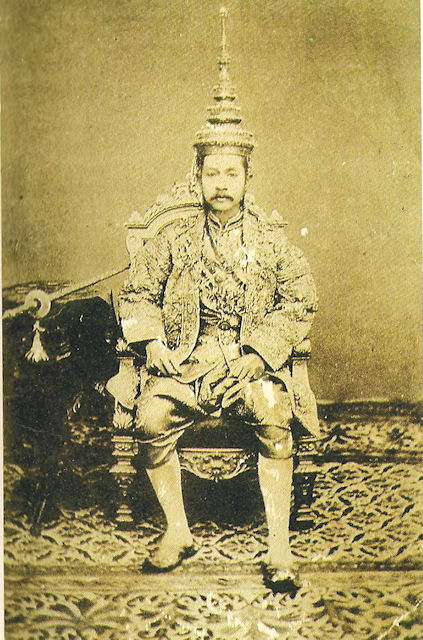
Abb.: Rama V., Postkarte, um 1890
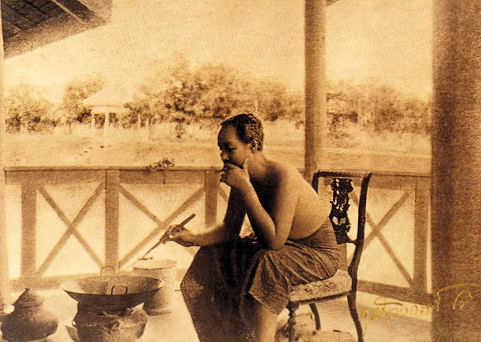
Abb.: Rama V. beim Rauchen und Kochen, 189x
[Bildquelle: Wikimedia. -- Public domain]

Königinnen:
Sunandha Kumariratana (สุนันทากุมารีรัตน์, 1860 - 1880)
Sukhumala Marasri (สุขุมาลมารศรี, 1861 - 1927)
Savang Vadhana (สว่างวัฒนา, 1862 - 1955)
Saovabha Bongsri (เสาวภาผ่องศรี, 1864 - 1919)
Abb.: Sunandha Kumariratana (สุนันทากุมารีรัตน์)
[Bildquelle: Wikipedia. -- Public domain]
Abb.: Denkmal für die ertrunkene Sunandha Kumariratana (สุนันทากุมารีรัตน์) und ihr ungeborenes Kind, Bang Pa In (บางปะอิน), 2008
[Bildquelle: ScorpianPK / th.Wikipedia. -- GNU FDLicense]
"Queen Sunandha Kumariratana (Thai:สุนันทากุมารีรัตน์ ;RTGS: —Sunantha Kumarirat—, 10 November 1860 - 31 May 1880) was a daughter of King Mongkut (Rama IV) and Princess Consort Piam (เจ้าคุณจอมมารดาเปี่ยม, 1838 - 1904). Her given name is Princess Sunandha Kumariratana (พระองค์เจ้าสุนันทากุมารีรัตน์). She was a half-sister and the first queen consort (พระบรมราชเทวี) and one of four queens of King Chulalongkorn (Rama V), two of which were her full-sibling younger sisters, Queen Savang Vadhana and Queen Saovabha Bhongsi. The queen and her daughter drowned when the royal boat capsized while on the way to the Bang Pa-In Royal Palace (พระราชวังบางปะอิน, Summer palace). Despite the presence of many onlookers, they were forbidden on pain of death to touch the queen - not even to save her life.[1] The grief-stricken Chulalongkorn later erected a memorial to her and his unborn son at the Bang Pa-In Palace."
[Quelle: http://en.wikipedia.org/wiki/Sunandha_Kumariratana. -- Zugriff am 2012-03-30]
Abb.: Sukhumala Marasri (สุขุมาลมารศรี)
[Bildquelle: th.Wikipedia. -- Public domain]
"Sukhumala Marasri (Thai: สุขุมาลมารศรี; RTGS: —Sukhuman Marasi—) (10 May 1861-9 July 1927) was a daughter of King Mongkut (Rama IV) and his concubine, Samli (เจ้าคุณจอมมารดาสำลี). Her given name was Princess Sukhumala Marasri (พระองค์เจ้าสุขุมาลมารศรี). She was later one of the four Queens Consort of King Chulalongkorn (Rama V) and was also his half-sister. Early life
Sukumala was born in Royal Grand Palace (พระบรมมหาราชวัง) on 10 May 1861. She was the 52nd child of King Mongkut and his concubine, Samli. She had a younger full sister, Princess Napaborn, and from her father’s side she was a half-sister to King Chulalongkorn (later her husband), Queen Sunandha Savang Vadhana, and Saovabha
When she was ten years old, King Mongkut died and was succeeded by Sukhumala Marasri's half-brother, Prince Chulalongkorn.
Life as queenAbout age 17, Sukhumala was married to King Chulalongkorn. The marriage produced two children; Princess Suddha Dibyaratana (later the Princess of Ratanakosin, สมเด็จพระเจ้าบรมวงศ์เธอ เจ้าฟ้าสุทธาทิพยรัตน์ สุขุมขัตติยกัลยาวดี กรมหลวงศรีรัตนโกสินทร, 1877 - 1922), who was also the first surviving Chao-Fah (เจ้าฟ้า), a child of the sovereign which their mother is the Queen Consort or a Princess by blood, and Prince Paribatra Sukhumbhand (later the Prince of Nakorn Sawan.สมเด็จพระเจ้าบรมวงศ์เธอ เจ้าฟ้าบริพัตรสุขุมพันธุ์ กรมพระนครสวรรค์วรพินิต, 1881 - 1944) In her husband’s reign she served as the King’s secretary and was referred to as “the Princess Consort.”
After her husband died, she moved to her son’s palace, Bang Khun Prom. During the reign of King Vajiravudh, her nephew, he officially named her as his father's fourth Queen Consort, making her official title Her Majesty Queen Sukhumala. When Prajadhipok succeeded to the throne, he gave his father's two surviving Queen consorts, Savang Vadhana and Sukhumala, the title of “the Queen Aunt.” In the same style Sukhumala was preceded by Savang Vadhana, reflecting the fact that Savang Vadhana was created Queen Consort by Chulalongkorn before Sukhumala.
Queen Consort Sukhumala Marasri died on 9 July 1927 at the age of 66 at the Bang Khun Prom Palace (H.R.H. Prince Paripatra Sukhumbhand Palace). Her only surviving child, Prince Paripatra Sukhumbhand, and her younger full sister, Princess Napaborn, were at her bed side."
[Quelle: http://en.wikipedia.org/wiki/Sukhumala_Marasri. -- Zugriff am 2012-03-30]
Abb.: Savang Vadhana (สว่างวัฒนา)
[Bildquelle: th.Wikipedia. -- Public domain]
Abb.: Savang Vadhana (สว่างวัฒนา) mit König Rama VIII. und Prinz Bumibol, 1938
[Bildquelle: Wikipedia. -- Public domain]
"Königin Savang Vadhana (Somdet Phra Sri Savarindira Boromma Rajadevi, Thai: สมเด็จพระศรีสวรินทิราบรมราชเทวี, auch Sri Savarindra, Thai: พระเจ้าลูกเธอ พระองค์เจ้าสว่างวัฒนา; * 10. September 1862 in Bangkok; † 17. Dezember 1955 ebendort) war Ehefrau von König Rama V. und Großmutter der thailändischen Könige Rama VIII. (Ananda Mahidol) und Rama IX. (Bhumibol Adulyadej). Nachdem ihr erster Enkel 1935 als König Rama VIII. den Thron von Siam bestiegen hatte, erhielt sie den Titel Somdet Phra Phan Vasa Ayyika Chao (สมเด็จพระพันวัสสาอัยยิกาเจ้า, "Königin-Großmutter"). Leben [Bearbeiten]
Savang Vadhana war die 27. Tochter von König Mongkut (reg. 1851 bis 1868) und dessen Ehefrau Piam, weshalb sie eine Halbschwester ihres späteren Gatten war. Aus der Ehe mit König Rama V. gingen acht Kinder hervor:
- Kronprinz Maha Vajirunhis (มหาวชิรุณหิศ, * 27. Juni 1878; † 4. Januar 1894)
- Prinz Isariyalongkorn (อิศริยาลงกรณ์, * 4. September 1879; † 25. September 1879)
- Prinzessin Vichitra Chiraprabha (วิจิตรจิรประภา, * 21. April 1881; † 15. August 1881)
- Prinz Sommatiwongse Varodaya (สมมติวงศ์วโรทัย, auch Prinz Sri Sri Dharmaraj; * 9. Juni 1882; † 17. Juni 1899)
- Prinzessin Valaya Alongkorn (วไลยอลงกรณ์, Prinzessin von Bejraburi - เพชรบุรี; * 16. April 1894; † 15. Februar 1938)
- Prinzessin Sirabhorn Sobhon (ศิราภรณ์โสภณ, * 19. Juli 1888; † 24. Mai 1898)
- Prinz Mahtala Dhibesra Adulyadej Vikrom (มหิตลาธิเบศร อดุลยเดชวิกรม, Prinz Mahidol Adulyadej - มหิดลอดุลยเดช; * 1. Januar 1891 in Bangkok; † 24. September 1929 ebendort)
- eine Prinzessin ohne Namen (im Alter von 3 Tagen gestorben)
Nachdem König Prajadipok 1935 abgedankt hatte, folgte ihm der Sohn von Königin Savang Vadhanas jüngstem Sohn als Ananda Mahidol auf den Thron. Auch dessen Nachfolger seit 1946, König Bhumibol Adulyadej, ist ein Enkel von Königin Savang Vadhana. Obwohl ihr eigener Sohn, Kronprinz Vajirunhis, bereits früh starb, lebte sie lang genug, um ihre beiden Enkel auf dem siamesischen (später thailändischen) Thron zu sehen.
Tod [Bearbeiten]Königin Savang Vadhana starb am 17. Dezember 1955 im Alter von 93 Jahren in Bangkok. Ihre Asche liegt auf dem Königlichen Friedhof im Wat Ratchabophit (วัดราชบพิธสถิตมหาสีมารามราชวรวิหาร) in Bangkok. Ein Wohnhaus der Königin kann in Bang Pa In (บางปะอิน) besichtigt werden. In ihren späten Lebensjahren bewohnte sie den Sa Pathum-Palast (วังสระปทุม), wo ein Museum zu ihrem Andenken eingerichtet wird.
Am 27. Oktober 2005 gründete Prinzessin Maha Chakri Sirindhorn (มหาจักรีสิรินธร, 1955 - ), eine Urgroßenkelin der Königin, die Königin Savang Vadhana-Stiftung (มูลนิธิสมเด็จพระพันวัสสาอัยยิกาเจ้า)."
[Quelle: http://de.wikipedia.org/wiki/Savang_Vadhana. -- Zugriff am 2012-03-30]
Abb.: Saovabha Bongsri (เสาวภาผ่องศรี)
[Bildquelle: Wikimedia. -- Public domain]
Abb.: Königin Saovabha Bongsri (เสาวภาผ่องศรี) mit (von links nach rechts): Prince Asdang Dejavudh (อัษฎางค์เดชาวุธ), Kronprinz Maha Vajiravudh, (มหาวชิราวุธ), Prinz Chakrabongse Bhuvanath (จักรพงษ์ภูวนาถ), Prinz Prajadhipok Sakdidej (ประชาธิปกฯ), Prinz Chudadhut Dharadilok (จุฑาธุชธราดิลก), ca. 1900
[Bildquelle: Wikipedia. -- Public domain]
"Queen Saovabha Bongsri (Thai: เสาวภาผ่องศรี; RTGS: Saowapha Phongsi) was a half-sister and queen of King Chulalongkorn (Rama V) of Thailand, and mother of both King Vajiravudh (Rama VI) and King Prajadhipok (Rama VII). As in accordance with Thai royal tradition, King Vajiravudh later bestowed on his mother the tile of "Queen Mother Sri Bajrindra" (Thai: ศรีพัชรินทรา; RTGS: Si Phatcharinthra). Life
Saovabha was born as a Princess of Siam by King Mongkut (or Rama IV) and Princess Consort Piyamavadi (Piam Sucharitakul, เจ้าคุณจอมมารดาเปี่ยม, 1838 - 1904). She was the youngest sister of the future Queen Sunandha Kumariratana and Queen Savang Vadhana. Saovabha became the consort of her half brother King Chulalongkorn sometime in 1878. She gave him 9 children, 5 would survive to adulthood (one died in infancy), two would eventually become King of Siam.
In 1897, Queen Saovabha became the first female Regent of Siam ((ผู้สำเร็จราชการแทนพระองค์)), when her husband went on a tour of Europe. When he returned he bestowed upon her the title of Somdet Phra Nang Chao Saovabha Bongsi Praborommarachininat (Thai: สมเด็จพระนางเจ้าเสาวภาผ่องศรี พระบรมราชินีนาถ) (roughly equivalent to H.M. the Queen Regent). During her time as queen she took many interests especially in the issues concerning women. In 1904 she established the first school for girls in Siam; the "Rajini School" (โรงเรียนราชินี)) or Queen's School in Bangkok.
She died in 1919 at the age of 57, She was given a grand Royal Funeral, attended by all members of the Siamese Royal Family, the ceremony was presided by her son King Vajiravudh. She plays a prominent posthumous role in the 1924 Palace Law of Succession (กฎมณเฑียรบาลว่าด้วยการสืบราชสันตติวงศ์ พระพุทธศักราช ๒๔๖๗), in which her son King Vajiravudh stipulated that her children would take precedent among all others over the line of succession. This guaranteed the accession of her youngest son Prince Prajadhipok to the throne in 1925, despite there being more senior and learned sons of Chulalongkorn. The Queen Saovabha Memorial Institute (สถานเสาวภา) was named after her.
ChildrenShe had 9 children with King Chulalongkorn:
- Princess Bahurada Manimaya (พาหุรัดมาณีมัย, 1878–1887)
- Crown Prince (สยามมกุฎราชกุมาร) Maha Vajiravudh, (มหาวชิราวุธ, later King Vajiravudh) (1880–1925)
- Prince Tribejrudhamrong (ตรีเพ็ชรุตม์ธำรง, 1881–1887)
- Prince Chakrabongse Bhuvanath (จักรพงษ์ภูวนาถ), Prince of Bisnulok (พิษณุโลก) (1882–1920)
- Prince Siriraj Kakudhabhanda (ศิริราชกกุธภัณฑ์, 1885–1887)
- Princess (unnamed) (1884)
- Prince Asdang Dejavudh (อัษฎางค์เดชาวุธ), Prince of Nakhon Rajasima (นครราชสีมา) (1889–1924)
- Prince Chudadhut Dharadilok (จุฑาธุชธราดิลก), Prince of Bejrapurana (เพ็ชรบูรณ์) (1892–1923)
- Prince Prajadhipok Sakdidej (ประชาธิปกฯ), Prince of Sukhothai (สุโขทัย), (later King Prajadhipok) (1893–1941)"
[Quelle: http://en.wikipedia.org/wiki/Saovabha_Bongsri. -- Zugriff am 2012-03-30]

Kinder von König Chulalongkorn (Rama V.):
Abb.: König Chulalonkorn (Rama V.) mit einem Teil seiner Kinder
Name Mother Birth Death Remarks 1. Princess Bongprabai - พระองค์เจ้าหญิงผ่อง Mom Rajawongse Khae Phungbun - เจ้าจอมมารดาหม่อมราชวงศ์แข พึ่งบุญ 19 December 1867 11 March 1942 - 2. Princess Srivilailakshana,
Princess of Subarn - พระองค์เจ้าหญิงศรีวิลัยลักษณ์Chao Khun Phra Prayurawongse (Pae Bunnag) - เจ้าคุณพระประยูรวงศ์ (เจ้าคุณจอมมารดาแพ บุนนาค) 24 July 1868 26 October 1904 - 3. Prince Isarawongse Vorarajkumar - พระองค์เจ้าชายอิศรวงศ์วรราชกุมาร Saeng Kalyanamitra - เจ้าจอมมารดาแสง กัลยาณมิตร 4 September 1869 5 June 1872 - 4. Princess Voralakshanavadi - พระองค์เจ้าหญิงวรลักษณาวดี Sud Sukumalachandra - เจ้าจอมมารดาสุด 12 June 1872 18 August 1926 5. Prince (Unnamed) - เจ้าฟ้าชาย HRH Princess Dakshinaja Naridiwasbutri - พระเจ้าบรมวงศ์เธอ พระองค์เจ้าทักษิณชา นราธิราชบุตรี 13 June 1872 13 June 1872 Death on Birthday 6. Princess Ajrabarni Rajkanya - พระองค์เจ้าหญิงอัจฉรพรรณีรัชกัญญา Talab Ketutat - เจ้าจอมมารดาตลับ 7 July 1872 15 November 1910 - 7. Princess Chudharatana Rajakumari - พระองค์เจ้าหญิงจุฑารัตนราชกุมารี Morakoth Benyakul - เจ้าจอมมารดามรกฎ เพ็ญกุล 17 December 1872 31 May 1930 - 8. Princess Chandra Saradavara,
Princess of Phichit - เจ้าฟ้าหญิงจันทราสรัทวารHH Princess Saovabhakya Nariratana - พระอรรคชายาเธอ พระองค์เจ้าเสาวภาคย์นารีรัตน์ 15 April 1873 21 February 1904 - 9. Princess Orabintu Benyabhak - พระองค์เจ้าหญิงอรพินทุ์เพ็ญภาค Mom Rajawongse Yoi Isarankura - เจ้าจอมมารดาหม่อมราชวงศ์ย้อย 27 April 1873 26 January 1935 - 10. Princess Suvabagtra Vilaibarn - พระองค์เจ้าหญิงสุวพักตร์วิไลยพรรณ Chao Khun Phra Prayurawongse (Pae Bunnag) - จ้าคุณพระประยูรวงศ์ (เจ้าคุณจอมมารดาแพ บุนนาค) 2 May 1873 30 July 1970 - 11. Princess Yaovamalaya Narumala,
Princess of Svargalok - เจ้าฟ้าหญิงเยาวมาลย์นฤมลHH Princess Ubolratana Narinag, Princess of Akavorarajgalya - พระอรรคชายาเธอ พระองค์เจ้าอุบลรัตนนารีนาค กรมขุนอรรควรราชกัลยา 4 June 1873 3 July 1909 - 12. Prince Kitiyakara Voralaksana,
Prince of Chanthaburi - พระองค์เจ้ากิติยากรวรลักษณ์Uam Bisalayaputra - เจ้าจอมมารดาอ่วม พิศลยบุตร 8 June 1874 27 November 1931 Originator of Princely House of Kitiyakorn. Grandfather of the current Queen Sirikit 13. Prince Nabhanka Nibandhabongs - พระเจ้าบรมวงศ์เธอ พระองค์เจ้านภางค์นิพัทธพงศ์ Saeng Kalyanamitra - เจ้าจอมมารดาแสง กัลยาณมิตร 8 August 1874 17 September 1876 - 14. Prince Rabi Badhanasakdi,
Prince of Rajaburi - พระองค์เจ้าชายรพีพัฒนศักดิ์Talab Ketutat - เจ้าจอมมารดาตลับ 21 October 1874 7 August 1920 Originator of Princely House of Rabibadhana 15. Prince Pravitra Vadhanodom,
Prince of Prachin - พระองค์เจ้าประวิตรวัฒโนดมCham Galyamitra - เจ้าจอมมารดาแช่ม กัลยาณมิตร 27 May 1875 9 December 1919 Originator of Princely House of Pravitra 16. Prince (Unnamed) - พระองค์เจ้า Cherm - เจ้าจอมมารดาเจิม - - Miscarriage on 1875 17. Princess Bandhavanna Varobhas - พระองค์เจ้าหญิงบัณฑวรรณวโรภาส Chao Khun Phra Prayurawongse (Pae Bunnag) - เจ้าคุณพระประยูรวงศ์ (เจ้าคุณจอมมารดาแพ บุนนาค) 25 November 1875 15 November 1891 - 18. Prince Chirapravati Voradej,
Prince of Nagara Jayasri - พระองค์เจ้าจิรประวัติวรเดชTabtim Rochanatisha - จ้าจอมมารดาทับทิม โรจนดิศ 7 November 1876 4 February 1913 Originator of Princely House of Chirapravati 19. Princess Beatrice Bhatrayuvadi - . พระองค์เจ้าหญิงบีเอตริศภัทรายุวดี Saeng Galyanamitra - เจ้าจอมมารดาแสง กัลยาณมิตร 5 December 1876 30 September 1913 - 20. Princess Suddha Dibyaratana,
Princess of Rattanakosindra - เจ้าฟ้าหญิงสุทธาทิพยรัตน์H.M. Queen Sukhumala Marasri - สมเด็จพระปิตุจฉาเจ้าสุขุมาลมารศรี พระอัครราชเทวี 14 September 1877 2 January 1922 - 21. Prince Maha Vajirunhis,
Crown Prince of Siam - เจ้าฟ้ามหาวชิรุณหิศH.M. Queen Savang Vadhana - สมเด็จพระศรีสวรินทิราบรมราชเทวี พระพันวัสสาอัยยิกาเจ้า (พระเจ้าลูกเธอ พระองค์เจ้าหญิงสว่างวัฒนา) 27 June 1878 4 January 1894 - 22. Princess Kannabhorn Bejaratana - เจ้าฟ้าหญิงกรรณาภรณ์เพชรรัตน์ | H.M. Queen Sunandha Kumariratana - สมเด็จพระนางเจ้าสุนันทากุมารีรัตน์ พระบรมราชเทวี 12 August 1878 31 May 1880 23. Prince (Unnamed) - เจ้าฟ้า H.M. Queen Sukhumala Marasri - สมเด็จพระปิตุจฉาเจ้าสุขุมาลมารศรี พระอัครราชเทวี - - Miscarriage on 1878 24. Princess Bahurada Manimaya , Princess Debnarirattana - เจ้าฟ้าพาหุรัดมณีมัย H.M. Queen Saovabha Bongsri - พระองค์เจ้าเสาวภาผ่องศรี 19 December 1878 27 August 1887 - 25. Princess Charoensri Chanamayu - พระองค์เจ้าเจริญศรีชนมายุ Saeng Kalyanamitra - เจ้าจอมมารดาแสง กัลยาณมิตร 31 March 1878 24 December 1916 - 26. Princess (Unnamed) - พระองค์เจ้าหญิง Bua - เจ้าจอมมารดาบัว 13 June 1879 13 June 1879 Death on Birthday 27. Prince Isariyalongkorn - เจ้าฟ้าอิศริยาลงกรณ์ H.M. Queen Savang Vadhana - สมเด็จพระศรีสวรินทิราบรมราชเทวี พระพันวัสสาอัยยิกาเจ้า (พระเจ้าลูกเธอ พระองค์เจ้าหญิงสว่างวัฒนา) 4 September 1879 25 September 1879 - 28. Princess Praves Vorasamai - พระองค์เจ้าหญิงประเวศวรสมัย Tabtim Rochanatisha - เจ้าจอมมารดาทับทิม โรจนดิศ 2 December 1879 31 May 1944 - 29. Prince (Unnamed) - เจ้าฟ้า H.M. Queen Saovabha Bongsri - พระองค์เจ้าเสาวภาผ่องศรี - - Miscarriage on 1879 30. Prince (Unnamed) - เจ้าฟ้า H.M. Queen Sunandha Kumariratana - สมเด็จพระนางเจ้าสุนันทากุมารีรัตน์ พระบรมราชเทวี Unborn 21 May 1880 - 31. Prince Abhakara Kiartivongse
, Prince of Jumborn - พระองค์เจ้าอาภากรเกียรติวงศ์Hmod Bunnag - เจ้าจอมมารดาโหมด บุนนาค 9 December 1880 19 May 1923 Originator of Princely House of Abhakara 32. Prince Maha Vajiravudh,
Prince of Dvaravati - เจ้าฟ้าชายมหาวชิราวุธH.M. Queen Saovabha Bongsri - พระองค์เจ้าเสาวภาผ่องศรี 1 January 1880 26 November 1925 Later King Vajiravudh (Rama VI) 33. Princess Vichitra Chiraprabha - เจ้าฟ้าวิจิตรจิรประภา H.M. Queen Savang Vadhana - สมเด็จพระศรีสวรินทิราบรมราชเทวี พระพันวัสสาอัยยิกาเจ้า (พระเจ้าลูกเธอ พระองค์เจ้าหญิงสว่างวัฒนา) 21 April 1881 15 August 1881 - 34. Princess Sasibongse Prabai - พระองค์เจ้าศศิพงประไพ Chandra - ศศิพงประไพ เจ้าจอมมารดาจันทร์ 26 April 1881 31 May 1934 - 35. Prince (Unnamed) - พระองค์เจ้าหญิง Sai Sukumalachandra - เจ้าจอมมารดาสาย 10 June 1881 11 June 1881 36. Prince Paribatra Sukhumbhand,
Prince of Nagara Svarga - เจ้าฟ้าบริพัตรสุขุมพันธ์H.M. Queen Sukhumala Marasri - สมเด็จพระปิตุจฉาเจ้าสุขุมาลมารศรี พระอัครราชเทวี 29 June 1881 18 January 1944 Originator of Princely House of Paribatra 37. Princess Bismai Bimalasataya - พระองค์เจ้าพิสมัยพิมลสัตย์ Ruen Sundarasardula - เจ้าจอมมารดาเรือน 20 December 1881 6 February 1936 - 38. Prince Purachatra Jayakara,
Prince of Gampaengbejra - พระองค์เจ้าบุรฉัตรไชยากรWad Galyanamitra - เจ้าจอมมารดาวาด กัลยาณมิตร 23 January 1881 14 September 1936 Originator of Princely House of Chatrajaya 39. Prince Tribej Rudhamrong - เจ้าฟ้าตรีเพชรุตม์ธำรง H.M. Queen Saovabha Bongsri - พระองค์เจ้าเสาวภาผ่องศรี 8 February 1881 22 November 1887 - 40. Prince Sommatiwongse Varodaya,
Prince of Sri Dharmaraj - เจ้าฟ้าสมมติวงศ์วโรทัยH.M. Queen Savang Vadhana - สมเด็จพระศรีสวรินทิราบรมราชเทวี พระพันวัสสาอัยยิกาเจ้า (พระเจ้าลูกเธอ พระองค์เจ้าหญิงสว่างวัฒนา) 16 April 1884 15 February 1938 - 41. Prince Benbadhanabongse ,
Prince of Bijaya - พระองค์เจ้าเพ็ญพัฒนพงศ์Morakoth Benyakul - เจ้าจอมมารดามรกฎ เพ็ญกุล 13 September 1882 11 November 1909 Originator of Princely House of Benbhadhana 42. Princess Oraongka Ankayuba - พระองค์เจ้าอรองค์อรรคยุพา Hmod Bunnag - เจ้าจอมมารดาโหมด บุนนาค 27 October 1882 20 February 1882 - 43. Prince Chakrabongse Bhuvanath ,
Prince of Bisnulok - เจ้าฟ้าจักรพงศภูวนาถH.M. Queen Saovabha Bongsri - พระองค์เจ้าเสาวภาผ่องศรี 3 March 1882 13 June 1920 Originator of Princely House of Chakrabongse 44. Prince Yugala Dighambara,
Prince of Lopburi - เจ้าฟ้ายุคลทิฆัมพรHH Princess Saisavali Biromya, Princess Suthasininart Piyamaharaj Padivaradda 17 March 1883 8 April 1932 Originator of Princely House of Yugol 45. Prince (Unnamed) - เจ้าฟ้า H.M. Queen Saovabha Bongsri - พระองค์เจ้าเสาวภาผ่องศรี - - Miscarriage on 1882 46. Prince (Unnamed) - เจ้าฟ้า H.M. Queen Saovabha Bongsri - พระองค์เจ้าเสาวภาผ่องศรี - - Miscarriage on 1882 47. Prince Vudhijaya Chalermlabh,
Prince of Singha - พระองค์เจ้าชายวุฒิไชยเฉลิมลาภTabtim Rochanatisha - เจ้าจอมมารดาทับทิม โรจนดิศ 5 December 1883 18 October 1947 Originator of Princely House of Vudhijaya 48. Princess Valaya Alongkorn ,
Princess of Bejraburi - เจ้าฟ้าหญิงวไลยอลงกรณ์H.M. Queen Savang Vadhana - สมเด็จพระศรีสวรินทิราบรมราชเทวี พระพันวัสสาอัยยิกาเจ้า (พระเจ้าลูกเธอ พระองค์เจ้าหญิงสว่างวัฒนา) 16 April 1884 15 February 1938 - 49. Prince Diloknobbarath,
Prince of Sarnga - พระองค์เจ้าชายดิลกนพรัฐPrincess Dipkesorn of Chaing Mai - เจ้าจอมมารดาเจ้าทิพเกษร ณ เชียงใหม่ 3 May 1884 12 January 1912 - 50. Princess Nabhachara Chamrassri - พระองค์เจ้าหญิงนภาจรจำรัสศรี HH Princess Saisavali Biromya, Princess Suthasininart Piyamaharaj Padivaradda 5 May 1884 31 August 1889 - 51. Prince Suriyong Prayurabandhu,
Prince of Jaya - พระองค์เจ้าสุริยงประยุรพันธุ์Hmod Bunnag - เจ้าจอมมารดาโหมด บุนนาค 27 July 1884 2 May 1919 Originator of Princely House of Suriyong 52. Princess Yaovabha Bongsanid - พระองค์เจ้าหญิงเยาวภาพงศ์สนิท M.R. Nueng Snidvongse - เจ้าจอมมารดาหม่อมราชวงศ์เนื่อง สนิทวงศ์ 28 August 1884 13 June 1934 - 53. Prince (Unnamed) - เจ้าฟ้า H.M. Queen Saovabha Bongsri - พระองค์เจ้าเสาวภาผ่องศรี - - Miscarriage on 1884 54. Princess Oraprabandh Rambai - พระองค์เจ้าหญิงอรประพันธ์รำไพ Aon Bunnag - เจ้าจอมมารดาอ่อน บุนนาค 7 July 1885 25 May 1933 - 55. Princess Malini Nobhadara ,
Princess of Srisajanalai - เจ้าฟ้าหญิงมาลินีนพดาราHH Princess Saisavali Biromya, Princess Suthasininart Piyamaharaj Padivaradda - พระวิมาดาเธอ พระองค์เจ้าสายสวลีภิรมย์ กรมพระสุทธาสินีนาฏ ปิยมหาราชปดิวรัดา 31 July 1885 26 December 1924 - 56. Princess Prabha Bannabilaya - พระองค์เจ้าหญิงประภาพรรณพิไลย Prom - เจ้าจอมมารดาพร้อม 31 August 1885 8 September 1948 57. Princess Prabai Bannabilas - พระองค์เจ้าหญิงประไพพรรณพิลาส Prom - เจ้าจอมมารดาพร้อม 31 August 1885 17 November 1886 - 58. Prince Rangsit Prayurasakdi,
Prince of Jayanad - พระองค์เจ้าชายรังสิตประยูรศักดิ์M.R. Nueng Snidvongse - เจ้าจอมมารดาหม่อมราชวงศ์เนื่อง สนิทวงศ์ 12 November 1885 7 March 1951 Originator of Princely House of Rangsit 59. Prince Siriraj Kakudhabhandu - เจ้าฟ้าศิริราชกกุธภัณฑ์ H.M. Queen Saovabha Bongsri - พระองค์เจ้าเสาวภาผ่องศรี 27 November 1885 31 May 1887 - 60. Princess Nibha Nobhadol,
Princess of Uthong - เจ้าฟ้าหญิงนิภานภดลHH Princess Saisavali Biromya, Princess Suthasininart Piyamaharaj Padivaradda - พระวิมาดาเธอ พระองค์เจ้าสายสวลีภิรมย์ กรมพระสุทธาสินีนาฏ ปิยมหาราชปดิวรัดา 4 December 1886 29 January 1935 - 61. Prince (Unnamed) - เจ้าฟ้า H.M. Queen Saovabha Bongsri - พระองค์เจ้าเสาวภาผ่องศรี - - Miscarriage on 1886 62. Princess Komala Saovamala - พระองค์เจ้าโกมลเสาวมาล Wong Netrayana - เจ้าจอมมารดาวง 19 September 1887 19 April 1890 - 63. Prince (Unnamed) - พระองค์เจ้า Aon Bunnag - เจ้าจอมมารดาอ่อน บุนนาค - - Miscarriage on 1887 64. Princess (Unnamed) - พระองค์เจ้าหญิง H.M. Queen Saovabha Bongsri - พระองค์เจ้าเสาวภาผ่องศรี 13 December 1887 13 December 1887 Death on Birthday 65. Princess Sirabhorn Sobhon - เจ้าฟ้าหญิงศิราภรณ์โสภณ H.M. Queen Savang Vadhana - สมเด็จพระศรีสวรินทิราบรมราชเทวี พระพันวัสสาอัยยิกาเจ้า (พระเจ้าลูกเธอ พระองค์เจ้าหญิงสว่างวัฒนา) 19 July 1888 24 May 1898 - 66. Prince Khajera Chirapradidha - พระองค์เจ้าเขจรจิรประดิษฐ Sae Rojanadis - เจ้าจอมมารดาแส โรจนดิศ 23 July 1888 7 October 1888 - 67. Prince Samaya Vudhirodom - พระองค์เจ้าสมัยวุฒิวโรดม Prom - เจ้าจอมมารดาพร้อม 13 September 1888 9 December 1889 - 68. Prince Isariyabhorn - พระองค์เจ้าอิศริยาภรณ์ M.R. Kesara Snidvongse - เจ้าจอมมารดาหม่อมราชวงศ์เกสร สนิทวงศ์ 21 October 1888 22 September 1892 - 69. Prince (Unnamed) - เจ้าฟ้า H.M. Queen Savang Vadhana - สมเด็จพระศรีสวรินทิราบรมราชเทวี พระพันวัสสาอัยยิกาเจ้า (พระเจ้าลูกเธอ พระองค์เจ้าหญิงสว่างวัฒนา) - - Miscarriage on 1888 70. Princess Adorndibyanibha - พระองค์เจ้าหญิงอาทรทิพยนิภา Chum Krairiksh - เจ้าจอมมารดาชุ่ม ไกรฤกษ์ 21 April 1889 23 March 1958 - 71. Prince (Unnamed) - เจ้าฟ้า HH Princess Saisavali Biromya, Princess Suthasininart Piyamaharaj Padivaradda - พระวิมาดาเธอ พระองค์เจ้าสายสวลีภิรมย์ กรมพระสุทธาสินีนาฏ ปิยมหาราชปดิวรัดา - - Miscarriage on 1889 72. Prince Asdang Dejavudh,
Prince of Nagara Rajasima - เจ้าฟ้าชายอัษฎางค์เดชาวุธH.M. Queen Saovabha Bongsri - พระองค์เจ้าเสาวภาผ่องศรี 12 May 1889 9 February 1924 - 73. Princess Vimolnaka Nabisi - พระองค์เจ้าหญิงวิมลนาคนพีสี H.H. Princess Dara Rasmi of Chiang Mai - เจ้าดารารัศมี พระราชชายา 2 October 1889 21 February 1892 - 74. Princess Abbhantripaja - พระองค์เจ้าหญิงอัพภันตรีปชา Sae Rojanadis - เจ้าจอมมารดาแส โรจนดิศ 31 October 1889 18 February 1934 - 75. Princess Adisaya Suriyabha - พระองค์เจ้าหญิงอดิสัยสุริยาภา Aon Bunnag - เจ้าจอมมารดาอ่อน บุนนาค 14 February 1889 27 January 1963 - 76. Prince (Unnamed) - พระองค์เจ้า Prom - เจ้าจอมมารดาพร้อม - - Miscarriage on 1889 77. Prince (Unnamed) - เจ้าฟ้า H.M. Queen Saovabha Bongsri - พระองค์เจ้าเสาวภาผ่องศรี - - Miscarriage on 1889 78. Prince (Unnamed) - พระองค์เจ้า Prom - เจ้าจอมมารดาพร้อม - - Miscarriage on 1890 79. Prince (Unnamed) - พระองค์เจ้า Mom Rajawongse Kesara Snidvongse - เจ้าจอมมารดาเกษร - - Miscarriage on 1890 80. Prince (Unnamed) - เจ้าฟ้า H.M. Queen Savang Vadhana - สมเด็จพระศรีสวรินทิราบรมราชเทวี พระพันวัสสาอัยยิกาเจ้า (พระเจ้าลูกเธอ พระองค์เจ้าหญิงสว่างวัฒนา) - - Miscarriage on 1890 81. Prince (Unnamed) - เจ้าฟ้า H.M. Queen Saovabha Bongsri - พระองค์เจ้าเสาวภาผ่องศรี - - Miscarriage on 1890 82. Princess Dibyalangkarn - พระองค์เจ้าหญิงทิพยาลังการ Sae Rojanadis - เจ้าจอมมารดาแส โรจนดิศ 17 March 1890 4 June 1932 - 83. Princess Suchitra Bharani - พระองค์เจ้าสุจิตราภรณี Chum Krairiksh - เจ้าจอมมารดาชุ่ม ไกรฤกษ์ 6 February 1890 26 October 1918 - 84. Princess Vapi Busbakara - พระองค์เจ้าหญิงวาปีบุษบากร Prom - เจ้าจอมมารดาพร้อม 25 June 1891 15 December 1982 - 85. Prince (Unnamed) - พระองค์เจ้า Aim - เจ้าจอมมารดาเอี่ยม - - Miscarriage on 1891 86. Prince (Unnamed) - พระองค์เจ้า Hem Amatyakul - เจ้าจอมมารดาเหม - - Miscarriage on 1891 87. The Prince Anusara Siriprasadh - พระองค์เจ้าชายอนุสรสิริประสาธน์ M.R. Kesara Snidvongse - เจ้าจอมมารดาเกษร 21 February 1891 6 May 1900 - 88. Princess Lavad Voraong - พระองค์เจ้าลวาดวรองค์ Luan Niyavanonda - เจ้าจอมมารดาเลื่อน นิยะวานนท์ 30 March 1891 30 March 1891 - 89. Prince Mahidol Adulyadej,
Prince of Songkla
later Prince Mahitala Dhibesra Adulyadej Vikrom, the Prince Father - เจ้าฟ้าชายมหิดลอดุลยเดชH.M. Queen Savang Vadhana - สมเด็จพระศรีสวรินทิราบรมราชเทวี พระพันวัสสาอัยยิกาเจ้า (พระเจ้าลูกเธอ พระองค์เจ้าหญิงสว่างวัฒนา) 1 January 1892 24 September 1929 Originator of Princely House of Mahidol. Father of the later Kings Ananda Mahidol (Rama VIII) and Bhumibol Adulyadej (Rama IX) 90. Prince Chudadhuj Dharadilok,
Prince of Bejrapurana - เจ้าฟ้าชายจุฑาธุชธราดิลกH.M. Queen Saovabha Bongsri - พระองค์เจ้าเสาวภาผ่องศรี 5 July 1892 8 July 1923 Originator of Princely House of Chudadhuj 91. Prince (Unnamed) - พระองค์เจ้า Aim - เจ้าจอมมารดาเอี่ยม - - Miscarriage on 1892 92. Prince (Unnamed) - พระองค์เจ้า Aon Bunnag - เจ้าจอมมารดาอ่อน บุนนาค - - Miscarriage on 1892 93. Princess (Unnamed) - พระองค์เจ้าหญิง M.R. Jew Kapittha - เจ้าจอมมารดาหม่อมราชวงศ์จิ๋ว 13 December 1892 25 January 1893 - 94. Princess Hemvadi - พระองค์เจ้าหญิงมัณฑณาภาวดี Hem Amatyakul - เจ้าจอมมารดาเหม 12 January 1892 17 October 1972 - 95. Prince Urubongs Rajsombhoj - พระองค์เจ้าชายอุรุพงศ์รัชสมโภช Luan Niyavanonda - เจ้าจอมมารดาเลื่อน นิยะวานนท์ 15 October 1893 20 September 1909 - 96. Prince Prajadhipok Sakdidej,
Prince of Sukothai - เจ้าฟ้าชายประชาธิปกศักดิเดชน์H.M. Queen Saovabha Bongsri - พระองค์เจ้าเสาวภาผ่องศรี 8 November 1893 30 May 1942 Later King Prajadhipok (Rama VII) 97. Princess (Unnamed) - เจ้าฟ้าหญิง H.M. Queen Savang Vadhana - สมเด็จพระศรีสวรินทิราบรมราชเทวี พระพันวัสสาอัยยิกาเจ้า (พระเจ้าลูกเธอ พระองค์เจ้าหญิงสว่างวัฒนา) 9 November 1893 12 November 1893 - [Quelle der Tabelle: http://en.wikipedia.org/wiki/List_of_children_of_Chulalongkorn + Thai-Wikipedia. -- Zugriff am 2012-04-04]
"Shortly after the consecration of the new King Chulalongkorn, to cower the Chinese, the Minister of Military Affairs staged "war manoevers" on the Field of Victory, opposite the Grand palace. Gunpowder was touched off, cannon roared, musketades spattered the air and three or four war elephants, most memorably the fearsome Brave Boy, demolished framework stockades and transfixed dummies with their tusks. Bluffed, Samphaeng [สำเพ็ง], the Chinese quarter, earlier the scene of fires and fighting, did not stir. " [Quelle: Battye, Noel Alfred <1935 - >: The military, government, and society in Siam, 1868-1910 : politics and military reform during the reign of King Chulalongkorn. -- 1974. -- 575 S. -- Diss., Cornell Univ. -- S. 78]
"In 1868, when the newly consecrated King Chulalongkorn circumambulated Bangkok in procession (analogue to the war train), the Siam Repository reported that "the military were all out" with "all the military paraphernalia that could be commanded". The report exaggerated just a touch. In the van there rode two cavalry squadrons, one of cuirassiers in French breast-plates armed with battle-axes and one of crossbow men dressed Yunnanese style. Presumably they rode stirrupless astride their Siamese ponies in high Burmese wooden saddles. Behind them marched 10, 000 men armed with antique cannon, flintlocks, bayonets, javelins, swords and bucklers, phkak, bows, long-handled axes (perhaps of Chinese origin), shot-guns, carbines, bills, tridents and clubs. Some of the weapons on ceremonial display were, of course, archaic; some never been popular with the Siamese; and some were theatrical. Some newer Western weapons did not appear in the parade. Allowance made for the bow, the phkak, old muskets with painted stocks and, yes, Armstrongs, the weapons passing in review still faithfully represented the technology of the battle-field. Most of the more specialised militiamen carried the weapons for hand-to-hand combat that fore-bears had carried into battle for centuries. Cabalistic banners (supernatural weapons of war, in which magic and divination were a goodly part of valor) flashed overhead. Traces of Western martial forms and occasional items of technology did not alter the traditional character of this "royal army"." [Quelle: Battye, Noel Alfred <1935 - >: The military, government, and society in Siam, 1868-1910 : politics and military reform during the reign of King Chulalongkorn. -- 1974. -- 575 S. -- Diss., Cornell Univ. -- S. 88f.]
Abb.: Armstrong gun
[Bildquelle: TWAMWIR / Wikimedia. -- Creative Commons Lizenz (Namensnennung, share alike)]
Zur Zeit von Rama I. besteht das Mahori-Orchester (วงมโหรี) aus zwölf Musikern.
1868 - 1873-11

Chaophraya Sisuriyawong (สมเด็จเจ้าพระยา บรมมหาศรีสุริยวงศ์ - Chuang Bunnag) ist Regent.
Der Regent führt 1868 ein Gericht für Chinesen ein, vor dem Streitfälle zwischen Chinesen nach chinesischem Recht entschieden werden.
Abb.: Chaophraya Sisuriyawong (สมเด็จ เจ้าพระยา บรมมหาศรีสุริยวงศ์), 1868
"Somdet Chao Phraya Borom Maha Si Suriyawongse (Thai: สมเด็จเจ้าพระยาบรมมหาศรีสุริยวงศ์) (personal name Chuang Bunnag) December 23, 1808 – January 19, 1883) was a prominent 19th century Thai figure and served as the regent during the early years of the reign of King Chulalongkorn. A member of a family originally of Persian origin,[1] Si (or Sri) Suriyawongse was born the eldest son of Dis (ดิศ) Bunnag (ดิศ บุนนาค, 1788 - 1855; Prayurawongse, สมเด็จเจ้าพระยาบรมมหาประยูรวงศ์) and Than Phuying Chan. Chuang was well educated for the time. King Mongkut made him Samuha Kalahom (สมุห สะ-ม-ุหะ กลาโหม), one of the two Ministers of old Siam.
RoleSi Suriyawongse, was one of the most important figures in the Mongkut's court. As he was the main supporter of Prince Mongkut to be enthroned, he eventually held the position of the Chancellor, or Samuha Kralahome, or the chief of the armed forces department. He was very well known as a pro-British official, or as a 'new generation' among the court's officials. He was interested in western learning in various fields such as science, engineering and steamship building, He had a very close relation with Prince Mongkut, the future Rama IV, supporting him to welcome British influence, western learning. He was also the key figure in promoting the Siam-British relationship, culminating in the Bowring Treaty in 1855, facilitating the economic relationship with Britain.
After the death of King Mongkut in 1868, his young son Prince Chulalongkorn became the new monarch. However, as the new king was underage, Si Suriyawongse was named as regent, a post he held until 1873.
He died in 1883 in Ratchaburi (ราชบุรี). Suriyawongse was also the first Thai to have a life insurance policy, after King Rama V granted foreign companies permission to extend their insurance business into Siam.
His son Won Bunnag succeeded him as Samuha Kalahom and also held the title Chao Phraya Suriyawongse."
[Quelle: http://en.wikipedia.org/wiki/Si_Suriyawongse. -- Zugriff am 2012-04-01]
1868 - 1910
Abb.: Münzen unter Rama V.
[Bildquelle: Grandpalace s / Wikipedia. -- Creative Commons Lizenz (Namensnennung)]
1868-11-16
Münzkrise
"At the beginning of Rama V’s reign, in B. E. 2411, there arose some commotion, since the masses were not happy to accept tin coins. Buying and selling virtually stopped in the Bangkok markets. The Government hurriedly came to a decision and made a declaration on the 12th day of Waning Moon in the 11th month of the Year of the Dragon, only 5 days after Rama V came to the throne. By the declaration those who surrendered copper and tin coins to the Government within 15 days would be given their full value in exchange. After the period had lapsed, they could be exchanged only at reduced rates. As far as copper coins were concerned, each seek [ซีก] would be equivalent to 1 at [อัฐ] (8 pieces amounting to 1 fueng [เฟื้อง]) and each siew [เสี้ยว] to 1 solos [โสฬส] (16 pieces amounting to 1 fueng [เฟื้อง]).
On the other hand, each at [อัฐ] tin coin would be equivalent to 20 bias [เบี้ย] (40 pieces amounting to 1 fueng [เฟื้อง]) and each solos [โสฬส] tin coin to 10 bias [เบี้ย] (80 pieces amounting to 1 fueng [เฟื้อง]).
Even though these reduced rates were announced by the Government, there was a further reduction of rates in private circles. For instance, the market rate for each at [อัฐ] tin coin was only 10 bias [เบี้ย] (80 pieces amounting to 1 fueng [เฟื้อง]), while that for each solos [โสฬส] tin coin was only 5 bias [เบี้ย] (160 pieces amounting to 1 fueng [เฟื้อง]).
Moreover, at [อัฐ] and solos [โสฬส] coins came to be called "ke" [เก๊] (forgeries) for a number of years."
[Übersetzt in: Prachoom Chomchai [ประชุม โฉมฉาย] <1931 - >: Chulalongkorn the great : a volume of readings edited and translated from Thai texts. -- Tokyo : Centre for East Asian Cultural Studies, 1965. -- 167 S. ; 19 cm. -- (East Asian cultural studies series ; no. 8.). -- S. 76]
1868
Edikt über höchsten Zinsatz:
"Die verbreitetste Art, sich Kredit zu verschaffen war früher, wie oben gezeigt worden ist, die, sich selber als Schuldsklaven zu verkaufen. Die persönliche Arbeit diente als Zins für das geliehene Kapital. Auch wurden oft Mobilien und Immobilien verpfändet. Der höchste gesetzliche Zinsfuss war früher 6% pro Monat. Jedoch musste nach Verlauf von drei Monaten der Zinsfuss auf 3,125% pro Monat herabgesetzt werden.
Da die Zinsen für die Bevölkerung zu hoch waren, so verkauften sich eben die Kreditbedürftigen als Schuldner, wobei sie noch den Vorteil hatten, nicht selbst für Nahrung, Kleidung und Wohnung sorgen zu müssen, solange sie im Dienste des Gläubigers standen.
Im Jahre 1868 wurde, wie früher dargestellt, die Sklaverei im wesentlichen beseitigt und die Kredit-Begehrer sahen sich jetzt in die unangenehme Lage versetzt, die hohen Zinsen zu bezahlen, wenn sie das nötige Kapital erhalten wollten. Deshalb wurde im selben Jahr 1868 ein Edikt erlassen, welches den Zinsfuss zu 1,25% pro Monat als Maximum (also auf 15% pro Jahr) festsetzte."
[Quelle: Dilock <Prinz von Siam> [Diloknobbarath, Prince of Sarnga - พระเจ้าบรมวงศ์เธอ พระองค์เจ้าดิลกนพรัฐ กรมหมื่นสรรควิสัยนรบดี] <1884 - 1912>: Die Landwirtschaft in Siam : ein Beitrag zur Wirtschaftsgeschichte des Königreichs Siam. -- Leipzig : Hirschfeld, 1908. -- 215 S. -- Zugleich: Univ. Tübingen, Diss. 1907. -- S. 199f.]
1868

Der französische Schmied Pierre Michaux (1813 - 1883) gründet die erste Fahrradfabrik.
Abb.: Michaux's Sohn auf Fahrrad, 1868-09
[Bildquelle: Le Cantaure Magazine / Wikimedia. -- Public domain]
1868-12-03 - 1874-02-17

William Ewart Gladstone (1809 - 1898) ist Prime Minister Großbritanniens.
Abb.: William Ewart Gladstone / von Phil May, ca. 1890
[Bildquelle: Wikimedia. -- Public domain]
1868-12-19

L'Illustration : journal universel <Paris, Frankreich>:
Abb.: "Somdetch-Chufa-Chulalonkorn, nouveau roi de Siam et de Laos" ; "Kalahome-Chow-Phya Sri Sury-Wongse [สมเด็จเจ้าพระยาบรมมหาศรีสุริยวงศ์], premier ministre du roi de Siam et de Laos". -- In: L'Illustration : journal universel <Paris, Frankreich>. -- 26 (1868). -- 1868-12-19. - Titelseite.
ausführlich: http://www.payer.de/thailandchronik/ressourcen.htm
Phongpaichit, Pasuk <ผาสุก พงษ์ไพจิตร, 1946 - > ; Baker, Chris <1948 - >: Thailand : economy and politics. -- Selangor : Oxford Univ. Pr., 1995. -- 449 S. ; 23 cm. -- ISBN 983-56-0024-4. -- Beste Geschichte des modernen Thailand.
Ingram, James C.: Economic change in Thailand 1850 - 1870. -- Stanford : Stanford Univ. Pr., 1971. -- 352 S. ; 23 cm. -- "A new edition of Economic change in Thailand since 1850 with two new chapters on developments since 1950". -- Grundlegend.
Akira, Suehiro [末廣昭] <1951 - >: Capital accumulation in Thailand 1855 - 1985. -- Tokyo : Centre for East Asian Cultural Studies, ©1989. -- 427 S. ; 23 cm. -- ISBN 4896561058. -- Grundlegend.
Skinner, William <1925 - 2008>: Chinese society in Thailand : an analytical history. -- Ithaca, NY : Cornell Univ. Press, 1957. -- 459 S. ; 24 cm. -- Grundlegend.
Mitchell, B. R. (Brian R.): International historical statistics : Africa and Asia. -- London : Macmillan, 1982. -- 761 S. ; 28 cm. -- ISBN 0-333-3163-0
Smyth, H. Warington (Herbert Warington) <1867-1943>: Five years in Siam : from 1891 to 1896. -- London : Murray, 1898. -- 2 Bde. : Ill ; cm.
ศกดา ศิริพันธุ์ = Sakda Siripant: พระบาทสมเด็จพระจุลจอมเกล้าเจ้าอยู่หัว พระบิดาแห่งการถ่ายภาพไทย = H.M. King Chulalongkorn : the father of Thai photography. -- กรุงเทพๆ : ด่านสุทธา, 2555 = 2012. -- 354 S. : Ill. ; 30 cm. -- ISBN 978-616-305-569-9